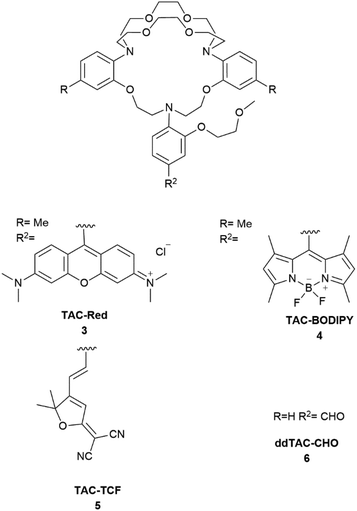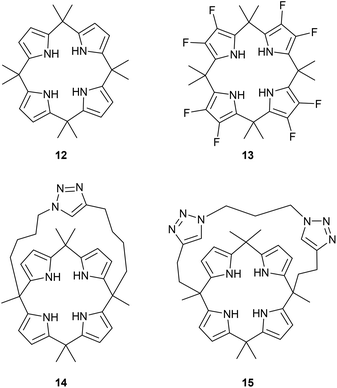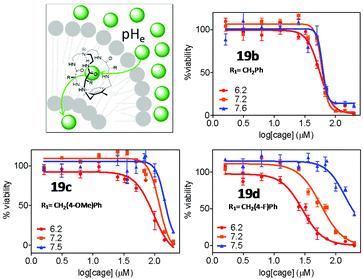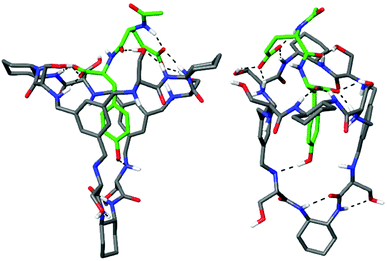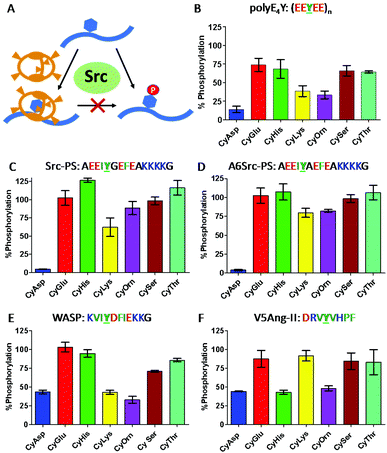 Open Access Article
Open Access ArticleMolecular cages for biological applications
Lucía
Tapia
,
Ignacio
Alfonso
 * and
Jordi
Solà
* and
Jordi
Solà
 *
*
Department of Biological Chemistry, Institute for Advanced Chemistry of Catalonia, IQAC-CSIC, Jordi Girona 18-26, 08034 Barcelona, Spain. E-mail: ignacio.alfonso@iqac.csic.es; jordi.sola@iqac.csic.es
First published on 6th October 2021
Abstract
Artificial receptors able to recognise biologically relevant molecules or ions have gained interest in the chemical community because they offer a plethora of posibilities. Molecular cage compounds are polycyclic compounds with a cavity designed for the encapsulation of guest species. Once inside the host cavity, the substrate can be transported through membranes and protected from the action of enzymes or other reactive species, thus offering the possibility of interfering with biological systems. Commonly, enzymes have been an inspiration for chemists in the search and design of defined cavities for different purposes. However, the chemical preparation of molecular cages has struggled with many synthetic challenges but this effort is worthwhile as they are a very promising tool for many applications ranging from sensing, delivery, purification or even promotion of/prevention from chemical modifications. Since the early reports at the end of the 60s, this field has experienced a growing interest; this review summarises the progress in the preparation and study of cage-like compounds highlighting their importance in biological applications.
Introduction
Non-covalent interactions are ubiquitous and govern almost every aspect of biological systems, from replication and transcription of genetic material to the structure and activity of biomacromolecules. In fact, the formation of host–guest systems can control the activity of proteins through the binding of an effector thus promoting transport, enzyme activity or starting signalling cascades.1,2 For years, supramolecular chemists have been focused on the design, preparation and study of small host–guest complexes, aiming to someday reach this complexity found in biological systems. However, mimicking the naturally occurring processes with artificial receptors remains a challenge. Inspired by nature, chemists have prepared compounds to specifically recognise relevant molecules in a biological context. The most conventional approach to that is to gradually increase the size and complexity of supramolecular systems to finally achieve the desired folding and functionality. Thus, chemists have designed some structures able to form cavities and recognition surfaces in order to bind the desired chemical species. Artificial receptors allow for the establishment of several non-covalent bonds like hydrogen bonding, hydrophobic, π–π, cation–π, anion–π, ionic interactions and even metal coordination in a cooperative manner. In biological systems, however, where water is present, hydrophobic interactions usually play the main role. In this context, molecular containers such as the long-known naturally occurring cyclodextrins,3,4 the versatile cucurbit[n]urils5–7 or the vase-like calix[n]arenes8–10 have been extensively studied and have found a wide-range of applications in different areas of biological chemistry. A particular case of synthetic receptors are cage compounds. The term ‘cages’ describes the molecular structure and, as defined by Kubik,11 consists of a roof, a floor and at least three bars connecting them. This definition excludes the above mentioned containers and limits the term to polycyclic compounds with a cavity designed for the encapsulation of guest molecules or ions. According to this description, cryptands,12,13 studied for the binding of cations14,15 and anions,16 were probably the first example of artificial cage-like molecules described. Since those early studies, diverse structures have been synthesised with the aim to selectively recognise and encapsulate biologically relevant substrates. Different approaches have been used to prepare molecular cages, from amide-based to fully-carbon backbones. In some cases, the use of templates can significantly improve the reaction yields and even allow the formation of unprecedented cages by pre-organizing the reactants. The use of reversible metal coordination bonds allows the formation of stable, well defined metallocages.17–19 Metal organic complexes offer a plethora of structural possibilities and it is possible to fine-tune the structures by optimizing either the ligands or the metals involved. The biological application of such compounds have widely been reviewed20–25 and falls out of the scope of this review. On the other hand, purely organic cages have the advantage that they are usually neutral and possess a higher stability relative to organometallic compounds since they are formed by covalent bonds. In this context, the emergence of new synthetic procedures like dynamic covalent chemistry has allowed new, more challenging, structures to be tackled.26 Despite this progress, the use of molecular organic cages in biological contexts is still very scarce and this is limiting the expansion of the field. Complexation of bio-molecules has many potential biomedical applications. For instance, sensing, enzyme monitoring or drug design are potential uses for these compounds. Besides, it can provide insights into significant biomolecular interaction mechanisms.27This review aims to present a broad vision of the field, from historical breakthroughs to recent developments in polymacrocyclic compounds and their application in the study or modulation of biological processes.
Chemosensors
Metal ions are extensively present in biological systems. They participate in many processes involved in life such as catalysis, transport, metabolic regulation or cell signalling. Dysregulation of these ions can cause several diseases and an excessive accumulation also can result in toxicity. Thus, detection and imaging of metal ion concentrations in biological media is a hot topic in biochemical research. As mentioned above, cryptands were probably the first three-dimensional cavities designed for ion recognition. These molecules show a great affinity for alkali metals even in aqueous solutions. The binding constants can be up to 5 orders of magnitude higher than their monocyclic analogues. Cryptands also show selectivity depending on their size, as crown ethers do.28 The nature of the cation–ligand interactions will also determine their affinity towards different cations. Ion–dipole interactions dominate in the case of oxygen atoms, favouring the recognition of alkali cations (hard electropositive cations). On the other hand, dative coordinative bonds dominate with nitrogen sites, being favourable for the binding of transition metal ions (soft cations).28These important features combined make cryptands a suitable platform for the development of selective chemosensors. Conjugation of cryptands with different fluorophores such as anthracene allows the detection of cations thanks to PET mechanisms.29–31 Thus, the detection of metal cations was one of the first examples of the use of cryptands in aqueous media. Not surprisingly, these compounds evolved to permit the monitoring of cations in real life samples.
Potassium is the major cation inside the cells and plays an important role in several processes like maintenance of electrolyte balance, acid–base homeostasis, hormone secretion or glucose and insulin metabolism to name a few. Detection and monitoring of potassium levels is critical to diagnose and understand some pathologies related to K+ levels. In a pioneer work, He and co-workers described a chemical sensor suitable for the measurement of extracellular potassium either in serum or blood samples based on a triazacryptand (TAC, 1) and a o-alkoxyaniline PET donor (compound 2, Fig. 1).32 This cryptand overcomes the use of PBFI (potassium binding bensofurane isophtalate), which uses an aza-18-crown-6 ether derivative as the recognition unit. This molecule is sensitive to potassium concentrations and allows to measure K+ flux in cells but, despite being commercially available, it has a poor selectivity in front of Na+.33 Conversely, He's sensor responds rapidly and reversibly to changes in K+ concentrations typical of blood samples and without interference of other analytes or to variations of pH (Fig. 1). The importance of this invention is highlighted by its use in the Roche OPTI CCA analyser, a commercially available blood analyser.
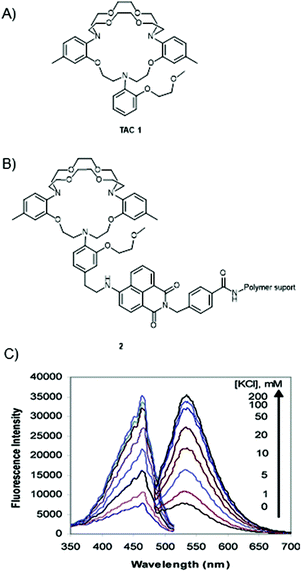 | ||
| Fig. 1 (A) Ttriazacryptand[2,2,3]-1-(2-methoxyethoxy) benzene (TAC). (B) He's design for an optical sensor. (C) Excitation and emission spectra of a sensor disk exposed to different potassium chloride solutions in TRIS-HEPES buffer at pH 7.40 (left, excitation spectra, fixed emission at 540 nm; right, emission spectra, fixed excitation at 470 nm. Reproduced with permission ref. 32, copyright American Chemical Society. | ||
Following this breakthrough, a number of TACs has been designed and synthesised for sensing and biological imaging. Verkman group prepared a series of sensors based on this ligand. For example, they reported the preparation of a water-soluble, K+ sensor, consisting of triazacryptand coupled to 3,6-bis(dimethylamino)xanthylium (TAC-Red 3, Fig. 2). The sensor showed specificity for K+, Rb+ and Cs+ over Na+ and Li+; the titration experiments showed an estimated lower detection limit of 0.2 mM for K+. Very importantly, divalent cations showed no fluorescence response. The long-wavelength excitation and bright fluorescence minimized interference from other blood components. As this compound was not cell-permeable they were able to stain the extracellular space of mouse brain by exposing the brain dura to a solution containing the sensor. Thus, after stimulation, the sensor was able to visualise K+ waves at the cortical surface in vivo.34 Later on, the same group reported the preparation of a green-fluorescing dextran conjugate of TAC-bodipy 4 useful for measuring K+ transport across cell membranes and selective against Cl− or Na+.35 Moreover, they developed a TAC-lime sensor (with green fluorescence) dextran conjugate, containing tetramethylrhodamine as reference chromophore with K+ red fluorescence. The dual probe allowed the determination of K+ in airway surface liquid (the thin fluid layer lining airway surface epithelial cells).36 Interestingly, the group also reported modifications of the triazacriptand (TAC) moiety that facilitated the synthesis greatly improving the yield and without losing recognition properties by removing 2 methyl groups of the sensor (ddTAC-CHO, 6)37 or by employing triazole moieties which reduced the cavity size and caused a slightly higher selectivity against other cations such as Cs+ or Rb+.38
Employing a TAC motif as recognition unit and a strong acceptor (TCF) Tian, Meldrum and co-workers developed a sensor able to detect K+ over a broad range of concentrations and, importantly, capable of imaging potassium ions in live-cells using confocal microscopy (Fig. 3).39 The TAC-TCF sensor 5 showed an increase of the fluorescence by around 4- and 50-fold upon the addition of K+ (concentrations between 140 to 1400 mM). Furthermore, TAC-TCF had a greater response for potassium over other cations such as Na+, Ca2+, Mg2+, Fe3+, Zn2+, Mn2+, or Cu2+ and, importantly, didn't affect cell viability. In Fig. 3, the K+ influx and efflux in response to stimuli is shown. Cells internalized with 4 μM of TAC-TFC were treated with KCl (20 mM) and nigerin, a ionophore, to promote the transport of potassium ions across the membrane. Enhanced fluorescence is observed after the addition of the ionophore, indicating K+ influx, efflux was observed after 3 minutes through a decrease of fluorescence which stabilised after 15 minutes.
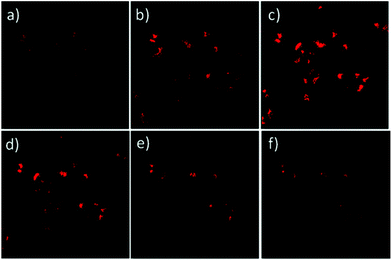 | ||
| Fig. 3 Time-dependent fluorescence of U87MG cells stimulated by nigericin and observed under confocal fluorescence microscope using TAC-TFC: (a) t = 0 (before the addition of nigericin) (b–f) t = 1, 3, 5, 10 and 15 min, respectively, after the addition of nigericin. Adapted with permission from ref. 39, copyright American Chemical Society. | ||
The same group also reported a polymerizable monomer formed by a TAC recognition moiety and a 4-amino-naphthalimide derived fluorophore containing a vinyl group. This monomer was able to penetrate human glioblastoma and oesophagus premalignant cell lines and be used to monitor K+ efflux. Moreover, thanks to the vinyl group the monomer was polymerised either with 2-hydroxyl methacrylate or acrylamide to give thin films useful for the measurement of extracellular K+ levels and thus measuring the efflux in E. coli and B. subtilis cells.40 Later on, the same authors reported a clever modification of a TAC-bodipy sensor. Introducing the lipophilic triphenylphosphonium cation (TPP+) into the molecule, they were able to target mitochondria (because of the accumulation of TPP+ in these organelles) and, consequently, to monitor K+ ion dynamics in them. The sensor has a good response in concentrations ranging from 30 to 500 mM, good brightness, a large dynamic range and remains insensitive to pH variations in the range 5.5–9.0.41 The same year Belfield reported a modified BODIPY-based sensor with red fluorescence that is also able to sensor K+ in living cells.42 An improved synthesis of BODIPY-TAC conjugated was reported by the same group and its use in imaging again confirmed in U87MG cells.43 More recently, Terai, Urano and co-workers described a BODIPY-TAC sensor covalently linked to the cell surface. Conjugation to HaloTag proteins allowed the visualization of [K+] changes in the cell membranes in real time.44
A few cryptands have been described for the recognition of cations other than alkali metals. Particularly, cages targeting transition metals have been described because of the relevance of this cations in environmental and biological processes. Kim and Bharadwaj described a cryptand-rhodamine conjugate sensor able to detect ppb of Hg(II) in aqueous media. Binding of Hg2+ to the cryptand promotes the opening of the spirolactam ring, and the resulting change in fluorescence emission can be detected by naked eye. The sensor also gave a good result in cell samples allowing it to be used in live cells, in this case HEL 293 cell line.45
Iron is the physiologically most abundant transition metal in biological systems and plays an important role in several processes. Thus, the Belfield group prepared a fluorescent probe for iron(III) based in a 10-diaza-18-crown-6 based cryptand and a unit of BODIPY attached as fluorophore platform to give compound 7. Upon Fe3+ coordination, the fluorescence quenching is supressed and the fluorescent emission enhanced. The cryptand is selective for Fe3+ upon a broad variety of metals, even able to discriminate from Cr3+ or Hg2+; the emission intensity was linearly related to the concentration of Fe3+ in the range of 0–200 equivalents (Fig. 4).46 Importantly, the cryptand showed no toxicity using HCT-116 cells (up to 25 μm) allowing its use in the detection of Fe3+ in live cells. Thus, after treatment with the sensor (20 μM, 10 minutes), cells incubated with a Fe3+ solution gradually showed increased fluorescence with incubation time. As expected, cells that were not treated with a Fe3+ solution displayed a fluorescence that remained fairly constant (Fig. 5).
 | ||
Fig. 4 (A) Cryptand-bodipy based sensor 7 for the detection of Fe3+. (B) Naked-eye fluorescence responses of 7 (7 μM) in H2O–CH3CN (9![[thin space (1/6-em)]](https://www.rsc.org/images/entities/char_2009.gif) : :![[thin space (1/6-em)]](https://www.rsc.org/images/entities/char_2009.gif) 1) upon addition of 100 equiv. of various metal cations (λex = 365 nm). Reproduced with permission from ref. 29, copyright American Chemical Society. 1) upon addition of 100 equiv. of various metal cations (λex = 365 nm). Reproduced with permission from ref. 29, copyright American Chemical Society. | ||
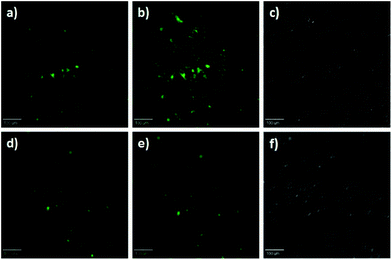 | ||
| Fig. 5 Images of live HCT-116 cells (a–c) in the presence of 30 μM Fe3+ solution in MEM medium and without Fe3+ (d–f) at (a and d) 0 and (b and e) 60 min after incubation with sensor 7 (20 μM). c and f are the phase contrast images of b and e, respectively. Reproduced with permission from ref. 46, copyright American Chemical Society. | ||
Carbohydrate recognition represents a formidable challenge for binding in aqueous media. Davis’ group has long been working in a series of cages able to bind monosaccharides47,48 and disaccharides49–51 using polycyclic compounds. The general strategy that the group has developed consists in preparing hosts with the ‘temple’ design. This design incorporates a ‘roof’ and a ‘floor’ composed of aromatic moieties capable to establish hydrophobic contacts reinforced by CH–π interactions (Fig. 6).52 These building motifs are linked by pillars containing polar groups able to form hydrogen bonds with the substrate. Thus, carbohydrates with all-equatorial substitution, with axial C–H atoms are recognised preferentially.
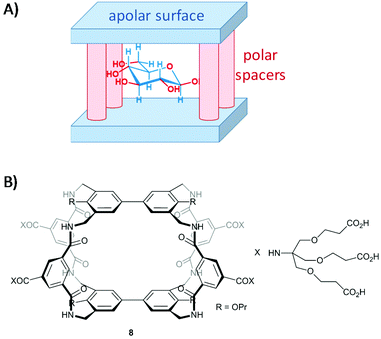 | ||
| Fig. 6 (A) Cartoon representation of the ‘temple’ design for recognition of all-equatorial carbohydrate recognition described by Davis.52 (B) A tricyclic monosaccharide receptor prepared by Davis group for the recognition of β-glucose (ref. 47). | ||
Using this successful approach, they described a much easier to synthetize compound 9 (Fig. 7A) which can be prepared in just 5 steps compared to the long synthesis (up to 21 steps) of previously reported cages. Surprisingly, with a simpler design compound 9 binds glucose more strongly than other monosaccharides (for example 50![[thin space (1/6-em)]](https://www.rsc.org/images/entities/char_2009.gif) :
:![[thin space (1/6-em)]](https://www.rsc.org/images/entities/char_2009.gif) 1 versus galactose). This selectivity allows 9 to act as a sensor for glucose in water in concentrations similar to those found in blood using fluorescence spectroscopy.53 Arguably compound 9 is not a cage since although it is a macrocyclic compound composed by roof and floor and two pillars it lacks a third pillar required to be considered a cage. Anyway, it follows the same principle for recognition and we found it relevant enough to be included in this section.
1 versus galactose). This selectivity allows 9 to act as a sensor for glucose in water in concentrations similar to those found in blood using fluorescence spectroscopy.53 Arguably compound 9 is not a cage since although it is a macrocyclic compound composed by roof and floor and two pillars it lacks a third pillar required to be considered a cage. Anyway, it follows the same principle for recognition and we found it relevant enough to be included in this section.
 | ||
| Fig. 7 (A) Macrocyclic artificial lectins described by Davis for the sensing of glucose 9 (ref. 33) and 10 (ref. 34). (B) CD spectra from the titration of D-glucose into filtered, diluted, glucose-free human serum, in the presence of L-glucose (2 mM) and 10 (0.25 mM). Modified from ref. 55 with permission from the Royal Society of Chemistry. | ||
Going a step further in their research, the group optimised the recognition of glucose in complex media. Thus, they prepared the bicyclic cage 10 which provides a cavity that almost perfectly complements the all-equatorial β-pyranoside substrates.54 The cage features several urea groups that provide an array of polar interactions and hydrogen bonding rationally designed by the authors. The receptor's affinity for glucose gives a Ka in the order of 18![[thin space (1/6-em)]](https://www.rsc.org/images/entities/char_2009.gif) 000 M−1, which compares to the affinity of lectins and glucose transporters. In addition, the binding to other saccharides is about 100 times lower. These high levels of affinity and selectivity allowed the group to explore 10 as sensor in real-world samples. This was achieved through the reading of the CD spectra induced by the binding of glucose to the achiral host (Fig. 7B). As the affinity of the receptor for glucose was too high for practical determinations at usual concentrations in blood, a competition experiment was developed. The addition of L-glucose effectively doubles the signal range from the CD spectrometer and allows sensitivity to be adjusted over a wide concentration range. Thus, the system was able to analyse the presence of glucose in human serum (although filtrated to remove interfering proteins), cell culture and beer.55
000 M−1, which compares to the affinity of lectins and glucose transporters. In addition, the binding to other saccharides is about 100 times lower. These high levels of affinity and selectivity allowed the group to explore 10 as sensor in real-world samples. This was achieved through the reading of the CD spectra induced by the binding of glucose to the achiral host (Fig. 7B). As the affinity of the receptor for glucose was too high for practical determinations at usual concentrations in blood, a competition experiment was developed. The addition of L-glucose effectively doubles the signal range from the CD spectrometer and allows sensitivity to be adjusted over a wide concentration range. Thus, the system was able to analyse the presence of glucose in human serum (although filtrated to remove interfering proteins), cell culture and beer.55
More recently, the same group has described cage 11 (Fig. 8) able to bind polysaccharides such as cellulose through a threading geometry.56 Polysaccharides, such as the mentioned cellulose, are not soluble in water, the formation of a threaded complex improved the water solubility of the bound polysaccharide. Solubilisation of these compounds could open the door to their use as feedstock chemicals through enzyme modification.
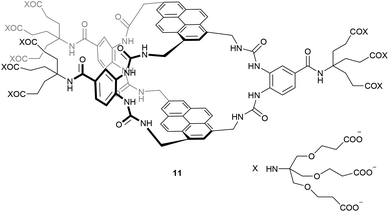 | ||
| Fig. 8 Receptor able to recognise and solubilize polysaccharides prepared by Davis.56 | ||
Ionophores
Molecular receptors that are able to cross membranes have a wide range of applications in biological research. Since they are able to transport chemical species in their interior, they can be used to deliver drugs otherwise insoluble or less able to cross the cell membranes. These molecules can also disrupt cell homeostasis by allowing the flux of ions.57 There are several natural cation selective ionophores which have indeed served as an inspiration for the design of artificial cationophores like for instance polycyclic ethers58 or cyclodextrins used as antibiotics.59 In the field of ionophores crown ethers also paved the way in the study of applications of supramolecular chemistry in biological environments.60 Early on, Lehn's group already demonstrated the ability of the related cryptands to transport alkali metals through lipid membranes.61,62 However, although a stronger binding may afford better selectivity this may be harmful in terms of transport when an ion flux is needed. Loiseau studied the effects of two cryptands: (221)C10 cryptand, selective for Na+, and the (222)C10 cryptand, selective for K+ in opossum kidney cells (OK). It was found that the cryptands inhibited the pH-sensitive K+ conductance of OK cells by inducing K+/H+ exchange at the plasma membrane. Moreover, the Na/K ATP synthase was inhibited due to the entry of K+ and Na+ into the mitochondria.63Anion transport across a membrane is more difficult because anions are usually more solvated than cations. In an early example Smith's group synthesised a ditopic macrobycicle able to bind NaCl or KCl and transport them through vesicle membranes.64 The biological relevance of Cl− transport across cell membranes turned it into the perfect target for ion transporters as it is related to several diseases with especial relevance like cystic fibrosis65 and cancer.66,67 At the cellular level, electrolyte imbalance, particularly chloride imbalance between intra and extracellular environments, often leads to apoptosis.68 A widely studied family of artificial compounds able to transport chloride are calix[4]pyrroles. These molecules offer many possibilities in the development of transmembrane ion transporters via different mechanisms. The pyrrolic N–H provides the capacity to bind anions and the aromatic cup to bind larger polarizable cations. Examples of calix[4]pyrroles with chloride binding properties are presented in Fig. 9. The first compound 12 acts as a CsCl co-transporter thus being electroneutral.69 Fluorination of the pyrrole rings enhances the NH acidity, increasing the Cl− binding and the transmembrane transport capacity of the molecules. This is why the second compounds, 13, is an efficient nitrate/chloride and bicarbonate/chloride exchanger thus capable of uniport across a membrane.70 As we have explained before, these two compounds cannot be considered cages as they are simple macrocycles with a conic shape, however, their modification to add a staple that links two opposite sides of the molecule converts them in cage compounds.
Gale and co-workers studied strapped calix[4]pyrroles (14 and 15 in Fig. 9) which showed Cl−/NO3− exchange in the presence of Cs+ but also as well as in the presence of Na+, K+, and Rb+.71,72 This is a clear example of the effect of both co-transport and anion exchange to the global transport activity of this family of compounds.73 Importantly, shorter strapped receptors showed certain selectivity for fluoride over chloride transport but also exhibited more selectivity for chloride transport over OH−.74
The activity of some pyridine diamide-strapped calix[4]pyrroles (16, Fig. 10) was studied in several cell lines by Gale, Sessler and Shin and they showed that these compounds mediate the coupled transport of chloride and sodium ions in liposomal models and also in living cells. Interestingly, the ester analogues 17, showed much reduced transport activity. The accumulation of chloride into the cells induces an increased concentration of reactive oxygen species (ROS). The increase of ROS levels leads to the release of cytochrome c from the mitochondria and ultimately induces apoptosis via caspase activation.75
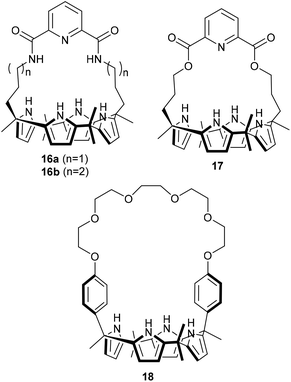 | ||
| Fig. 10 Amides (16a,b) and ester (17) strapped calyx[4]yrroles studied by Gale, Sessler and Shin75 and calix[4]pyrrol-oligoether conjugate 18 described by Lee, Sessler and Gale.76 | ||
More recently, the same group demonstrated that the Cl−/Na + accumulation inside cells promoted by compound 16a induces osmotic stress in the cells. This osmotic stress leads to the generation of reactive oxygen species (ROS) and leads to caspase-dependent apoptotic cell death (Fig. 11).77,78
Linking a calix[4]pyrrol recognition motif to an oligoether moiety, Lee, Sessler, and Gale groups reported the preparation of ditopic ion-pair receptor 18. This chimeric molecule presents both anion and cation binding sites in close proximity and, therefore, is able to bind halide anion salts through the formation of ion-pair complexes.76 Compound 18 was found to form complexes with F− and Cl− as the appropriate salts but also with metal cations such as K+, Na+, Li+, Cs+ (as perchlorate salts). Ion depending interactions showed that both the nature of the cation and the anion affected the binding constant. The binding mode was different depending on the alkali metal employed, for example K+ was found to be bound to the polyether strap whereas Cs+ was bound to the lower part (cup) of the calixpyrrole. Compound 18 was shown able to transport alkali metal salts (NaCl, KCl, RbCl) in model membrane transport studies using unilamellar POPC vesicles. The most lipophilic cations showed more transport activities (Cs+ > Rb+ > K+ > Na+).
Using chloride as a template for the synthesis, our group has reported the preparation of pseudopeptidic cages with a cavity that encapsulates chloride anions (Fig. 12).79,80 The controlled size of the cavity suites chloride much better than any other inorganic anions and, consequently, the association constants are at least two orders of magnitude higher for chloride.79 These compounds were shown to facilitate the transmembrane transport of chloride in model phospholipid bilayers. The peripheral substitution proved to be critical for the transport as cages sharing the same binding motif for chloride exhibited very different interaction and transport properties depending on the lipophilicity of the compound.80 Going a step further, we proved that the anionophores displayed pH dependent activity, with a better transport occurring at acidic pH which implies a H+/Cl− symport mechanism. The NMR studies performed in DPC micelles demonstrated that the cages bind chloride within the lipid phase, and that both chloride binding and exchange are more efficient at acidic pH. We took advantage of the fact that the chloride affinity and transport improve at lower pH to selectively induce cell death of cancer cells because the cages display higher cytotoxicity in the presence of pH gradients resembling those characteristic of tumour microenvironments (Fig. 13).81
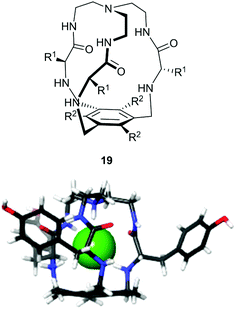 | ||
| Fig. 12 General chemical structure of chloride receptors 19 based on pseudopeptidic tripodal cages (top) and crystal structure of compound 19a (R1 = CH2Ph(4-OH), R2 = Me, bottom). | ||
Transport of other anions different from chloride has been much less developed. Iodide selective transport using molecular containers (not cages) like β-cyclodextrins82 and calix[4]arenes has been reported.83 Using dynamic covalent chemistry Roh and Kim reported a porphyrin based organic cage able to transports iodide ions. The cage was constructed from square-shaped building units with different substitution (3-and 4-substituted) and had a large internal cavity, comparable to the thickness of bilayer membranes. The transport of a diverse range of anions was promoted by a dehydration-driven, channel mechanism in vesicles.84 In addition, the organic cage seemed to be able to promote iodide transport across the membrane of a living cell. This was demonstrated using cells transfected with yellow fluorescent protein (YFP-H148Q/I152L) which is quenched by iodide, proving its potential usefulness in living systems.
Sulphate is one of the most common anions in plasma and it is involved in a number of biological processes.85 However, sulphate transport through lipid bilayers is also very challenging because of its high hydrophilicity, being poorly investigated. Jolliffe, Gale and co-workers reported the transport abilities through membrane bilayers of a series of compounds based on tris-ureas and tris-thioureas. Among them the cyclopeptidic cage compounds 20 and 21 were studied (Fig. 14). Compounds 20 and 21 proved to be able to transport chloride in POPC vesicles using a selective electrode. Control experiments showed that these molecules act as molecular carriers rather than membrane spanning channels. Moreover, using 33S NMR techniques they obtained evidence for transmembrane sulphate transport by receptor 21, whereas receptor 20 was unable to transport this anion.
 | ||
| Fig. 14 Cryptand-like tris-thioureas described by Jolliffe and Gale for the transport of sulphate.86 | ||
Imaging
Positron emission tomography (PET) provides valuable information in the diagnosis and treatment of different diseases. PET relies on administering radioactive tracers containing positron-emitting isotopes and then detecting the radiation, 18F being commonly used since the 60s. Metal-based PET radiotracers have become increasingly used in preclinical and clinical studies, particularly the emitting isotopes of copper, gallium and zirconium.87 The development of these agents requires chelators with in vivo stability and able to be conjugated with targeting molecules (antibodies, peptides, etc.). A few examples of this application will be discussed in this section. The hexaazamacrobicyclic sarcophagine cage Sar 22 (Fig. 15) forms very stable complexes with Cu2+ that do not dissociate under physiological conditions. Sargeson described the conjugation of a Sar derivative to monoclonal antibodies targeting disialogangliosides for tumour specific PET imaging agent using neuroblastoma and melanoma model systems.88 The same chelator was used by Rogers to prepare a conjugate of bombesin, a peptide that binds to gastrin-releasing peptide receptor (GRPr) overexpressed in cancer cells. The conjugate was able thus to deliver Cu into PC-3 prostate cancer cells.89 Similar cages with different handlers have been used to prepare conjugates with peptides for the PET imaging of tumours.90,91 Other targets like active platelets have also been addressed with the appropriate antibody-chelator conjugates, thus delivery of 64Cu allows the early diagnosis of thrombotic events.92 More recently a Sar-conjugated antibody targeting epidermal growth factor receptor (EGFR) showed high-quality PET images in mouse models.93 The sarcophagine chelator, MeCOSar (23, Fig. 15A), was attached to the antibody cetuximab by treating the antibody with the N-hydroxysuccinimdyl ester MeCOSar-NHS. On the other hand, the anti-EGFR murine monoclonal antibody, Fab528 was conjugated to the Sar derivative 24 by means of an enzymatic coupling. In Fig. 15B the in vivo PET images following administration of [64Cu][CuMeCOSar]-cetuximab in A431 xenograft tumour-bearing NSG mice at different times are shown. Tumour uptake was evident at 1 h post-administration but the best tumour: background ratio is obtained after 24 h.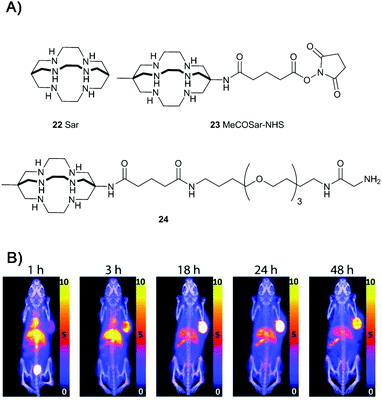 | ||
| Fig. 15 (A) Sarcophagine cage and derivatives. (B) In vivo PET imaging of A431 xenograft tumor-bearing NSG mice following administration of [64Cu][CuMeCOSar]-cetuximab at different times. Reproduced from ref. 93 with permission from the Royal Society of Chemistry. | ||
Sarcofagine functionalised ligands with tumour targeting peptides have also been used with Ga3+ allowing to use commercially available 68Ge/68Ga generators for their use as radiopharmaceutical agents.94 Finally, other kinds of chelators have been described for other metals. Wadas group prepared di-macrocyclic terephthalamide ligands for the stabilization of 89Zr which are highly stable in vivo allowing the use of this element in PET imaging.95
Complexation of biomolecules
Complexation of bio-molecules has many potential biomedical applications: for instance, sensing, enzyme monitoring or drug design. Besides, it can provide insights into significant biomolecular interaction mechanisms. The complexation of natural products using artificial receptors is a major topic in supramolecular chemistry. Non covalent interactions with biomolecules (amino acids, biopolymers, enzymes or nucleic acids), which are the fundaments of many pharmacological activities, can be studied using supramolecular model complexes. Also in the biochemistry field, supramolecular complexes are being used for the protection, transport or targeting of bioactive molecules. Encapsulation in a suitable host can provide selectivity in the protection of natural drugs from metabolism or even the manipulation of the guest redox properties.The disruption of metaloenzymes by metal coordination or sequestration offers a way to deactivate their activity. Following this idea, the group of García-España reported a series of pyrazole-containing macrocyclic and cryptand-like compounds active against the iron superoxide dismutase (Fe-SOD), an essential enzyme for the survival of the protozoan Trypanosoma cruzi, responsible of the Chagas disease. Among them, compound 25(Fig. 16) showed great in vitro and in vivo activity against intra and extracellular forms of the parasite being the most effective compound, especially against the chronic phase. Importantly, the compound was highly selective for Fe-SOD when compared to human CuZn-SOD enzyme.96 The close structural similarity of the Fe-SOD enzymes in T. cruzi and Leishmania spp. induced the group to study the antiproliferative activity of some compounds, including 25, against Leishmania infantum and Leishmania braziliensis species. The results showed again that compound 25 was highly leishmanicidal and induced extensive parasite cell damage.97
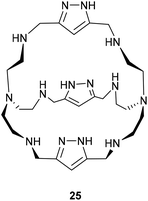 | ||
| Fig. 16 Macrobicyclic compound 25 described by García-España with anti-Trypanosoma cruzi and anti-leishmaniosis activity. | ||
Pseudopeptidic cages offer a suitable platform to work in biological media. On the one hand, a variety of amino acids is available which allow a broad structural and functional diversity. On the other hand, the non-peptidic part can be modulated to implement the desired functions. In the last years, we have been working on the design and applications of pseudopeptidic cages. In 2012 we described the efficient synthesis of macrobicyclic pseudopeptidic compounds with two strategies, using organic anion templates and driving the formation of the product by forcing the configuration of the building blocks.98 We described the synthesis of a family of pseudopeptidic macrocycles with relatively high yields using a 3 + 2 imine condensation to form the most thermodynamically stable product followed by the in situ reduction of the imine group (Scheme 1). It is worth mentioning that this one-pot reaction involves the formation of 6 covalent bonds in two steps which means a total of 12 reactions. This reaction can be carried out using a template (5TBA) but the final products are also obtained without template if the mixture is allowed to reach the equilibrium for enough time (24 h).
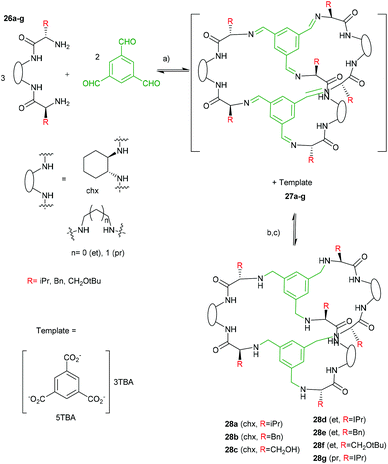 | ||
| Scheme 1 Synthesis of pseudopeptidic cages described by Alfonso.98 (a) Equilibrium at RT either in the absence or the presence of 5TBA. (b) BH3·py (c) HCl. | ||
The recognition properties of different cages prepared following the synthesis described in Scheme 1. Those compounds were investigated for the recognition N-protected dipeptides.99 The interactions were measured through different techniques (NMR, MS and in some cases fluorescence emission spectroscopy) which allowed the determination of the association constant of each cage-receptor pair. Very interesting conclusions were extracted from this work: cyclohexane gives a rigidity to the moiety that is beneficial for the recognition of most dipeptides. Moreover, the side chains (R substituents) of the cage also play an important role in the recognition. For instance, Ser and Val enhance the interaction whereas Phe residues reduce it. The highest binding constants were found to be with the dipeptides containing aromatic rings (Phe and Tyr). With all the data collected from the different interaction studies (NMR, MS and molecular modelling analysis) and considering the stereoselection observed with the Ac-EY-OH dipeptide, an interaction model was proposed, which implies the inclusion of the aromatic Tyr residue within the cage cavity, along with a number of ionic and H-bonding host–guest interactions (Fig. 17).100
Given the promising results, new cage-like compounds were synthetized with the (R,R)-cyclohexane-1,2-diamine and Lys and Orn residues (CyLys and CyOrn, respectively). Those showed better affinity for Tyr residues in short peptides and also in a polypeptide (PolyE4Y). This was relevant because EYE epitope is a known substrate for protein tyrosine kinases (PTKs). The affinity of both CyOrn and CyLys for this sequence was better than those of the other cages (CySer, CyThr) due to the positive charge of the Lys and Orn residues that allows secondary electrostatic interactions between glutamic residues of the polypeptide and the side chains of the cage. CyLys and CyOrn were proven to inhibit PTK activity by protecting the Tyr from phosphorylation using a commercial assay kit. The kinase inhibition was in agreement with the Kd found for CyLys and CyOrn and showed that CyLys is the most efficient cage for kinase inhibition.100,101 Moreover, the selective encapsulation of Tyr was also demonstrated in polypeptides containing several tyrosines and in short peptide with different sequences. More recently, we have extended the research to other cages (CyHis, CyAsp and CyGlu, based on His, Asp or Glu residues, respectively) and examined their protective action in the Src mediated phosphorylation of a series of Tyr containing peptides (Fig. 18). Remarkably, the inhibition of the Src-mediated phosphorylation depends on both the peptide sequence and the side chain of the cages. The binding constants were determined by fluorescence emission titrations considering the different equilibria present in the reaction media (for example dimerization of the peptide substrates in the concentration used was taken into account).
Importantly, the binding affinities of the cages strongly correlate with the inhibitory efficiency of the cages. As general trend the Asp cage was the most efficient inhibitor with Lys, Orn, and His showing interesting activities that deeply depended on the nature of the substrate. Overall, it could be concluded that the inhibitory effect of the cages was due to the protective action resulting from Tyr encapsulation within the cage while the binding strongly depends on the additional interactions between the side chains of the pseudopeptidic cages and the amino acid sequences surrounding the Tyr residue in the peptides. Interestingly, we also demonstrated that the cage protects peptides from phosphorylation in a completely different tyrosine kinase system, highlighting the general application of the concept.
Conclusions and outlook
The preparation of cage-like compounds with a well-defined inner cavity is synthetically challenging. However, these compounds can recognize biologically relevant molecules and ions with great levels of efficiency and selectivity providing a particularly valuable tool in biological chemistry. Thus, the usual synthetic effort is rewarded with useful applications in imaging, transport enzyme disruption or biomolecule protection. In addition, although the acquired knowledge and even the intuition of chemists will always play an important role in the design of these hosts, new synthetic approaches and technologies will facilitate the preparation of challenging cages. In this regard, we have seen how template dynamic covalent chemistry allows the preparation of new cages with improved yields. This new methodology will allow to tackle bigger, more complex structures. Probably other approaches like semi-synthesis from biomacromolecules will come to the aid of chemists. The more advanced separation and analytical tools will also play an important role in order to elucidate and study new structures. Along this review we have shown how the properties greatly depend on the cavity, thus the affinity for a given target is usually determined by the interactions within the cavity. However, external decoration, that is, the interactions of the outer surface with the media (including solvent, cell membranes, interactions with other residues of a biomacromolecule) are equally critical to define a function. In order to design new improved receptors, one must bear in mind several physicochemical parameters such as solubility, transport (ability to cross lipidic membranes), toxicity, emission properties, stability in biological media, etc. As we have been through several receptors, organic synthetic cages offer good binding properties, stability and the possibility to functionalise the outer structure without interfering with the binding. For these reasons we strongly believe that although still scarce, their importance will grow as chemists and biologist will dare to tackle more challenging problems such as protein–protein interactions or signalling cascades. In this not-so-distant future cage-based molecular compounds will certainly play an important role.Author contributions
Conceptualisation (L. T., I. A. and J. S.), writing-original manuscript (J. S.), writing-review and edition (L. T., I. A. and J. S.), funding acquisition (I. A.).Conflicts of interest
There are no conflicts to declare.Acknowledgements
Financial support from the Spanish Ministry of Science and Innovation (RTI2018-096182-B-I00, RED2018-102331-T, MCI/AEI/FEDER, EU), AGAUR (2017 SGR 208) and personal support for L. Tapia (BES-2016-076863) are gratefully acknowledged. We acknowledge support of the publication fee by the CSIC Open Access Publication Support Initiative through its Unit of Information Resources for Research (URICI).Notes and references
- T. W. Traut, Allosteric Regulatory Enzymes, Springer US., New York, 2008 Search PubMed.
- T. D. Pollard, W. Earnshaw, J. Lippincott-Schwartz and G. Johnson., Cell biology, Elsevier, Philadelphia, 2017 Search PubMed.
- G. Crini, Chem. Rev., 2014, 114, 10940–10975 CrossRef CAS PubMed.
- W. Sliwa and T. Girek, Cyclodextrins: Properties and Applications, Wiley-VCH Verlag GmbH & Co. KGaA, 2017 Search PubMed.
- K. Kim, N. Selvapalam, Y. H. Ko, K. M. Park, D. Kim and J. Kim, Chem. Soc. Rev., 2007, 36, 267–279 RSC.
- S. J. Barrow, S. Kasera, M. J. Rowland, J. del Barrio and O. A. Scherman, Chem. Rev., 2015, 115, 12320–12406 CrossRef CAS PubMed.
- D. Das, K. I. Assaf and W. M. Nau, Front. Chem., 2019, 7, 619 CrossRef CAS PubMed.
- F. N. Pur, Mol. Divers., 2016, 20, 781–787 CrossRef PubMed.
- M. M. Naseer, M. Ahmed and S. Hameed, Chem. Biol. Drug Des., 2017, 89, 243–256 CrossRef CAS PubMed.
- R. Kumar, A. Sharma, H. Singh, P. Suating, H. S. Kim, K. Sunwoo, I. Shim, B. C. Gibb and J. S. Kim, Chem. Rev., 2019, 119, 9657–9721 CrossRef CAS PubMed.
- S. Kubik, in Chemistry of Nanocontainers, ed. M. Albrecht and E. Hahn, Springer Berlin Heidelberg, Berlin, Heidelberg, 2012, pp. 1–34 Search PubMed.
- B. Dietrich, in Comprehensive Supramolecular Chemistry, ed. G. W. Gokel, Elsevier, Oxford, 1996, pp. 153–211 Search PubMed.
- J. M. Lehn, Pure Appl. Chem., 1977, 49, 13 Search PubMed.
- B. Dietrich, J. M. Lehn and J. P. Sauvage, Tetrahedron Lett., 1969, 10, 2885–2888 CrossRef.
- B. Dietrich, J. M. Lehn and J. P. Sauvage, Tetrahedron Lett., 1969, 10, 2889–2892 CrossRef.
- C. H. Park and H. E. Simmons, J. Am. Chem. Soc., 1968, 90, 2431–2432 CrossRef CAS.
- R. Chakrabarty, P. S. Mukherjee and P. J. Stang, Chem. Rev., 2011, 111, 6810–6918 CrossRef CAS PubMed.
- T. R. Cook and P. J. Stang, Chem. Rev., 2015, 115, 7001–7045 CrossRef CAS PubMed.
- N. J. Young and B. P. Hay, Chem. Commun., 2013, 49, 1354–1379 RSC.
- N. Ahmad, H. A. Younus, A. H. Chughtai and F. Verpoort, Chem. Soc. Rev., 2015, 44, 9–25 RSC.
- H. Sepehrpour, W. Fu, Y. Sun and P. J. Stang, J. Am. Chem. Soc., 2019, 141, 14005–14020 CrossRef CAS PubMed.
- J. W. Steed, Chem. Soc. Rev., 2009, 38, 506–519 RSC.
- T. R. Cook, V. Vajpayee, M. H. Lee, P. J. Stang and K.-W. Chi, Acc. Chem. Res., 2013, 46, 2464–2474 CrossRef CAS PubMed.
- E. G. Percástegui, T. K. Ronson and J. R. Nitschke, Chem. Rev., 2020, 120, 13480–13544 CrossRef PubMed.
- G. Yu, M. Jiang, F. Huang and X. Chen, Curr. Opin. Chem. Biol., 2021, 61, 19–31 CrossRef CAS PubMed.
- M. Mastalerz, Angew. Chem., Int. Ed., 2010, 49, 5042–5053 CrossRef CAS PubMed.
- H. J. Schneider, P. Agrawal and A. K. Yatsimirsky, Chem. Soc. Rev., 2013, 42, 6777–6800 RSC.
- J. M. Lehn and J. P. Sauvage, J. Am. Chem. Soc., 1975, 97, 6700–6707 CrossRef CAS.
- A. P. de Silva, H. Q. N. Gunaratne and K. R. A. S. Sandanayake, Tetrahedron Lett., 1990, 31, 5193–5196 CrossRef.
- K. Golchini, M. Mackovic-Basic, S. A. Gharib, D. Masilamani, M. E. Lucas and I. Kurtz, Am. J. Physiol.: Renal Physiol., 1990, 258, F438–F443 CAS.
- S. B. Maity and P. K. Bharadwaj, Inorg. Chim. Acta, 2012, 381, 58–77 CrossRef CAS.
- H. He, M. A. Mortellaro, M. J. P. Leiner, R. J. Fraatz and J. K. Tusa, J. Am. Chem. Soc., 2003, 125, 1468–1469 CrossRef CAS PubMed.
- A. Minta and R. Y. Tsien, J. Biol. Chem., 1989, 264, 19449–19457 CrossRef CAS.
- P. Padmawar, X. Yao, O. Bloch, G. T. Manley and A. S. Verkman, Nat. Methods, 2005, 2, 825–827 CrossRef CAS PubMed.
- W. Namkung, P. Padmawar, A. D. Mills and A. S. Verkman, J. Am. Chem. Soc., 2008, 130, 7794–7795 CrossRef CAS PubMed.
- W. Namkung, Y. Song, A. D. Mills, P. Padmawar, W. E. Finkbeiner and A. S. Verkman, J. Biol. Chem., 2009, 284, 15916–15926 CrossRef CAS PubMed.
- R. D. Carpenter and A. S. Verkman, Eur. J. Org. Chem., 2011, 1242–1248 CrossRef CAS PubMed.
- R. D. Carpenter and A. S. Verkman, Org. Lett., 2010, 12, 1160–1163 CrossRef CAS PubMed.
- X. Zhou, F. Su, Y. Tian, C. Youngbull, R. H. Johnson and D. R. Meldrum, J. Am. Chem. Soc., 2011, 133, 18530–18533 CrossRef CAS PubMed.
- X. Zhou, F. Su, W. Gao, Y. Tian, C. Youngbull, R. H. Johnson and D. R. Meldrum, Biomaterials, 2011, 32, 8574–8583 CrossRef CAS PubMed.
- X. Kong, F. Su, L. Zhang, J. Yaron, F. Lee, Z. Shi, Y. Tian and D. R. Meldrum, Angew. Chem., Int. Ed., 2015, 54, 12053–12057 CrossRef CAS PubMed.
- B. Sui, X. Yue, B. Kim and K. D. Belfield, ACS Appl. Mater. Interfaces, 2015, 7, 17565–17568 CrossRef CAS PubMed.
- B. Sui, X. Yue, M. G. Tichy, T. Liu and K. D. Belfield, Eur. J. Org. Chem., 2015, 1189–1192 CrossRef CAS.
- T. Hirata, T. Terai, H. Yamamura, M. Shimonishi, T. Komatsu, K. Hanaoka, T. Ueno, Y. Imaizumi, T. Nagano and Y. Urano, Anal. Chem., 2016, 88, 2693–2700 CrossRef CAS PubMed.
- A. Jana, J. S. Kim, H. S. Jung and P. K. Bharadwaj, Chem. Commun., 2009, 4417–4419, 10.1039/B907646H.
- B. Sui, S. Tang, T. Liu, B. Kim and K. D. Belfield, ACS Appl. Mater. Interfaces, 2014, 6, 18408–18412 CrossRef CAS PubMed.
- N. P. Barwell, M. P. Crump and A. P. Davis, Angew. Chem., Int. Ed., 2009, 48, 7673–7676 CrossRef CAS PubMed.
- E. Klein, M. P. Crump and A. P. Davis, Angew. Chem., Int. Ed., 2005, 44, 298–302 CrossRef CAS PubMed.
- Y. Ferrand, M. P. Crump and A. P. Davis, Science, 2007, 318, 619 CrossRef CAS PubMed.
- B. Sookcharoenpinyo, E. Klein, Y. Ferrand, D. B. Walker, P. R. Brotherhood, C. Ke, M. P. Crump and A. P. Davis, Angew. Chem., Int. Ed., 2012, 51, 4586–4590 CrossRef CAS PubMed.
- J. D. Howgego, C. P. Butts, M. P. Crump and A. P. Davis, Chem. Commun., 2013, 49, 3110–3112 RSC.
- A. P. Davis, Org. Biomol. Chem., 2009, 7, 3629–3638 RSC.
- C. Ke, H. Destecroix, M. P. Crump and A. P. Davis, Nat. Chem., 2012, 4, 718–723 CrossRef CAS PubMed.
- R. A. Tromans, T. S. Carter, L. Chabanne, M. P. Crump, H. Li, J. V. Matlock, M. G. Orchard and A. P. Davis, Nat. Chem., 2019, 11, 52–56 CrossRef CAS PubMed.
- R. A. Tromans, S. K. Samanta, A. M. Chapman and A. P. Davis, Chem. Sci., 2020, 11, 3223–3227 RSC.
- T. J. Mooibroek, J. M. Casas-Solvas, R. L. Harniman, C. M. Renney, T. S. Carter, M. P. Crump and A. P. Davis, Nat. Chem., 2016, 8, 69–74 CrossRef CAS PubMed.
- I. Alfonso and R. Quesada, Chem. Sci., 2013, 4, 3009–3019 RSC.
- K. C. Nicolaou, M. O. Frederick and R. J. Aversa, Angew. Chem., Int. Ed., 2008, 47, 7182–7225 CrossRef CAS PubMed.
- H. Yamamura, K. Suzuki, K. Uchibori, A. Miyagawa, M. Kawai, C. Ohmizo and T. Katsu, Chem. Commun., 2012, 48, 892–894 RSC.
- M. Kralj, L. Tušek-Božić and L. Frkanec, ChemMedChem, 2008, 3, 1478–1492 CrossRef CAS PubMed.
- M. Castaing and J. M. Lehn, J. Membr. Biol., 1987, 97, 79–95 CrossRef CAS PubMed.
- M. Castaing, F. Morel and J. M. Lehn, J. Membr. Biol., 1986, 89, 251–267 CrossRef CAS PubMed.
- A. Loiseau, C. Leroy and M. Castaing, Biochim. Biophys. Acta, Biomembr., 1997, 1330, 39–49 CrossRef CAS.
- A. V. Koulov, J. M. Mahoney and B. D. Smith, Org. Biomol. Chem., 2003, 1, 27–29 RSC.
- R. Planells-Cases and T. J. Jentsch, Biochim. Biophys. Acta, Mol. Basis Dis., 2009, 1792, 173–189 CrossRef CAS PubMed.
- S. Hong, M. Bi, L. Wang, Z. Kang, L. Ling and C. Zhao, Oncol. Rep., 2015, 33, 507–514 CrossRef CAS PubMed.
- K. O. Alfarouk, S. B. M. Ahmed, A. Ahmed, R. L. Elliott, M. E. Ibrahim, H. S. Ali, C. C. Wales, I. Nourwali, A. N. Aljarbou, A. H. H. Bashir, S. T. S. Alhoufie, S. S. Alqahtani, R. A. Cardone, S. Fais, S. Harguindey and S. J. Reshkin, Cancers, 2020, 12, 898 CrossRef CAS PubMed.
- S. P. Yu, L. M. T. Canzoniero and D. W. Choi, Curr. Opin. Cell Biol., 2001, 13, 405–411 CrossRef CAS PubMed.
- C. C. Tong, R. Quesada, J. L. Sessler and P. A. Gale, Chem. Commun., 2008, 6321–6323, 10.1039/B814988G.
- P. A. Gale, C. C. Tong, C. J. E. Haynes, O. Adeosun, D. E. Gross, E. Karnas, E. M. Sedenberg, R. Quesada and J. L. Sessler, J. Am. Chem. Soc., 2010, 132, 3240–3241 CrossRef CAS PubMed.
- M. Yano, C. C. Tong, M. E. Light, F. P. Schmidtchen and P. A. Gale, Org. Biomol. Chem., 2010, 8, 4356–4363 RSC.
- M. G. Fisher, P. A. Gale, J. R. Hiscock, M. B. Hursthouse, M. E. Light, F. P. Schmidtchen and C. C. Tong, Chem. Commun., 2009, 3017–3019 RSC.
- S. Peng, Q. He, G. I. Vargas-Zúñiga, L. Qin, I. Hwang, S. K. Kim, N. J. Heo, C.-H. Lee, R. Dutta and J. L. Sessler, Chem. Soc. Rev., 2020, 49, 865–907 RSC.
- H. J. Clarke, E. N. W. Howe, X. Wu, F. Sommer, M. Yano, M. E. Light, S. Kubik and P. A. Gale, J. Am. Chem. Soc., 2016, 138, 16515–16522 CrossRef CAS PubMed.
- S.-K. Ko, S. K. Kim, A. Share, V. M. Lynch, J. Park, W. Namkung, W. Van Rossom, N. Busschaert, P. A. Gale, J. L. Sessler and I. Shin, Nat. Chem., 2014, 6, 885–892 CrossRef CAS PubMed.
- I.-W. Park, J. Yoo, B. Kim, S. Adhikari, S. K. Kim, Y. Yeon, C. J. E. Haynes, J. L. Sutton, C. C. Tong, V. M. Lynch, J. L. Sessler, P. A. Gale and C.-H. Lee, Chem. – Eur. J., 2012, 18, 2514–2523 CrossRef CAS PubMed.
- S.-H. Park, S.-H. Park, E. N. W. Howe, J. Y. Hyun, L.-J. Chen, I. Hwang, G. Vargas-Zuñiga, N. Busschaert, P. A. Gale, J. L. Sessler and I. Shin, Chem, 2019, 5, 2079–2098 CAS.
- R. Quesada, Chem, 2019, 5, 1924–1926 CAS.
- I. Martí, M. Bolte, M. I. Burguete, C. Vicent, I. Alfonso and S. V. Luis, Chem. – Eur. J., 2014, 20, 7458–7464 CrossRef PubMed.
- I. Martí, J. Rubio, M. Bolte, M. I. Burguete, C. Vicent, R. Quesada, I. Alfonso and S. V. Luis, Chem. – Eur. J., 2012, 18, 16728–16741 CrossRef PubMed.
- L. Tapia, Y. Pérez, M. Bolte, J. Casas, J. Solà, R. Quesada and I. Alfonso, Angew. Chem., Int. Ed., 2019, 58, 12465–12468 CrossRef CAS PubMed.
- N. Madhavan, E. C. Robert and M. S. Gin, Angew. Chem., Int. Ed., 2005, 44, 7584–7587 CrossRef CAS PubMed.
- I. Izzo, S. Licen, N. Maulucci, G. Autore, S. Marzocco, P. Tecilla and F. De Riccardis, Chem. Commun., 2008, 2986–2988 RSC.
- B. P. Benke, P. Aich, Y. Kim, K. L. Kim, M. R. Rohman, S. Hong, I.-C. Hwang, E. H. Lee, J. H. Roh and K. Kim, J. Am. Chem. Soc., 2017, 139, 7432–7435 CrossRef CAS PubMed.
- D. Markovich, Physiol. Rev., 2001, 81, 1499 CrossRef CAS PubMed.
- N. Busschaert, L. E. Karagiannidis, M. Wenzel, C. J. E. Haynes, N. J. Wells, P. G. Young, D. Makuc, J. Plavec, K. A. Jolliffe and P. A. Gale, Chem. Sci., 2014, 5, 1118–1127 RSC.
- L. E. McInnes, S. E. Rudd and P. S. Donnelly, Coord. Chem. Rev., 2017, 352, 499–516 CrossRef CAS.
- S. D. Voss, S. V. Smith, N. DiBartolo, L. J. McIntosh, E. M. Cyr, A. A. Bonab, J. L. J. Dearling, E. A. Carter, A. J. Fischman, S. T. Treves, S. D. Gillies, A. M. Sargeson, J. S. Huston and A. B. Packard, Proc. Natl. Acad. Sci. U. S. A., 2007, 104, 17489 CrossRef CAS PubMed.
- K. A. Lears, R. Ferdani, K. Liang, A. Zheleznyak, R. Andrews, C. D. Sherman, S. Achilefu, C. J. Anderson and B. E. Rogers, J. Nucl. Med., 2011, 52, 470 CrossRef CAS PubMed.
- E. Gourni, L. Del Pozzo, E. Kheirallah, C. Smerling, B. Waser, J.-C. Reubi, B. M. Paterson, P. S. Donnelly, P. T. Meyer and H. R. Maecke, Mol. Pharm., 2015, 12, 2781–2790 CrossRef CAS PubMed.
- B. M. Paterson, P. Roselt, D. Denoyer, C. Cullinane, D. Binns, W. Noonan, C. M. Jeffery, R. I. Price, J. M. White, R. J. Hicks and P. S. Donnelly, Dalton Trans., 2014, 43, 1386–1396 RSC.
- B. M. Paterson, K. Alt, C. M. Jeffery, R. I. Price, S. Jagdale, S. Rigby, C. C. Williams, K. Peter, C. E. Hagemeyer and P. S. Donnelly, Angew. Chem., Int. Ed., 2014, 53, 6115–6119 CrossRef CAS PubMed.
- S. E. Rudd, J. K. Van Zuylekom, A. Raicevic, L. A. Pearce, C. Cullinane, C. C. Williams, T. E. Adams, R. J. Hicks and P. S. Donnelly, Chem. Sci., 2021, 12, 9004–9016 RSC.
- M. T. Ma, O. C. Neels, D. Denoyer, P. Roselt, J. A. Karas, D. B. Scanlon, J. M. White, R. J. Hicks and P. S. Donnelly, Bioconjugate Chem., 2011, 22, 2093–2103 CrossRef CAS PubMed.
- D. N. Pandya, S. Pailloux, D. Tatum, D. Magda and T. J. Wadas, Chem. Commun., 2015, 51, 2301–2303 RSC.
- M. Sánchez-Moreno, C. Marín, P. Navarro, L. Lamarque, E. García-España, C. Miranda, O. Huertas, F. Olmo, F. Gómez-Contreras, J. Pitarch and F. Arrebola, J. Med. Chem., 2012, 55, 4231–4243 CrossRef PubMed.
- P. Navarro, M. SÁNchez-Moreno, C. MarÍN, E. García-España, I. Ramírez-Macías, F. Olmo, M. J. Rosales, F. Gómez-Contreras, M. J. R. Yunta and R. Gutierrez-Sánchez, Parasitology, 2014, 141, 1031–1043 CrossRef CAS PubMed.
- A. Moure, S. V. Luis and I. Alfonso, Chem. – Eur. J., 2012, 18, 5496–5500 CrossRef CAS PubMed.
- E. Faggi, A. Moure, M. Bolte, C. Vicent, S. V. Luis and I. Alfonso, J. Org. Chem., 2014, 79, 4590–4601 CrossRef CAS PubMed.
- E. Faggi, C. Vicent, S. V. Luis and I. Alfonso, Org. Biomol. Chem., 2015, 13, 11721–11731 RSC.
- E. Faggi, Y. Perez, S. V. Luis and I. Alfonso, Chem. Commun., 2016, 52, 8142–8145 RSC.
| This journal is © The Royal Society of Chemistry 2021 |




